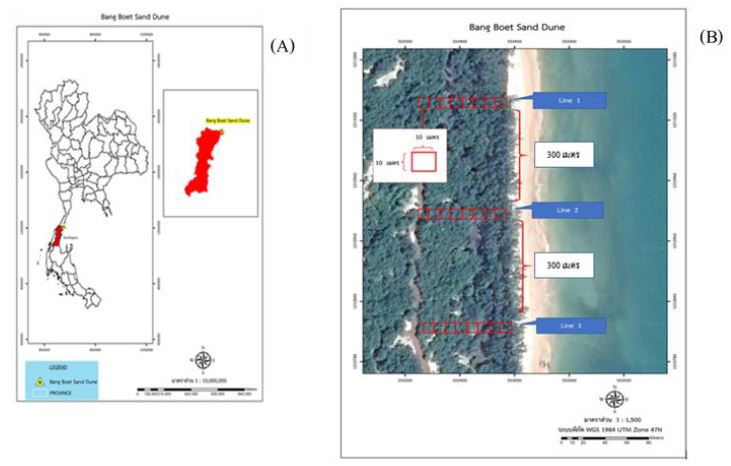The Influence of Shelter Belt on Forest Structure at Bang Boet Coastal Sand Dune, Pathio District, Chumphon Province
Keywords:
Forest restoration, Natural succession, Species diversity, Beach forestAbstract
The influence of sea breezes has high impact on the plant establishment on the beach forest. The creation of shelter-belt may reduce the wind speed and support for plant regeneration. This study aimed to detect the influence of shelter-belt on forest structure at Bang Boet coastal sand dune. Three permanent plots were established in natural coastal sand dune and behind shelter-belt of Casuarina equisetifolia planting in 2014 and 2016, respectively. All plants with DBH >= 1 cm were tagged, measured and species identified which the regeneration monitoring was done every year. The forest structure of plant community behind shelter-belt was analyzed, including, plant community classification between sites, natural coastal sand dune and behind shelter-belt of Casuarina equisetifolia, was also monitored based on data in 2020. The results showed that 39 species from 37 genera and 26 families were found in the sand dune behind shelter-belt. High tree density with DBH >= 1 cm was found (8,138 trees/ha-1) with basal area of 18.35 m2/ha-1. Moderate diversity based on Shannon-Weiner (H') index was found (H' = 2.88). The result form Non-metric multidimensional scaling (NMDS) showed that two plant community groups were classifiied; 1) leeward and behind shelter-belt group, and 2) leeward group. The dominance species in first group was mostly tree and shrubby tree habit such as Mischocarpus sundaicus, Syzygium antisepticum, Planchonella obovate, Syzygium grande, Ochna integerrima, Syzygium claviflorum, Suregada multiflora and Aporosa planchoniana, while, the latter group was shrub and shrubby tree habit, particular, Pandanus odorifer and Scaevola taccada. Indicating shelter-belt creating had strongly supported plant community succession at leeward side similar to the leeward site. The diameter class distribution of Casuarina equisetifolia had a unimodal form which contrasted to the others, indicating high susceptibility to maintain it population, even though, it facilitated the suitable environments for others plant establishment. Thus, the shelter-belt with suitable species such as Syzygium grande, Planchonella obovata and Pandanus odorifer, had high influenced on species conservation and the restoration of coastal sand dune or beach forest.
Downloads



.png)





